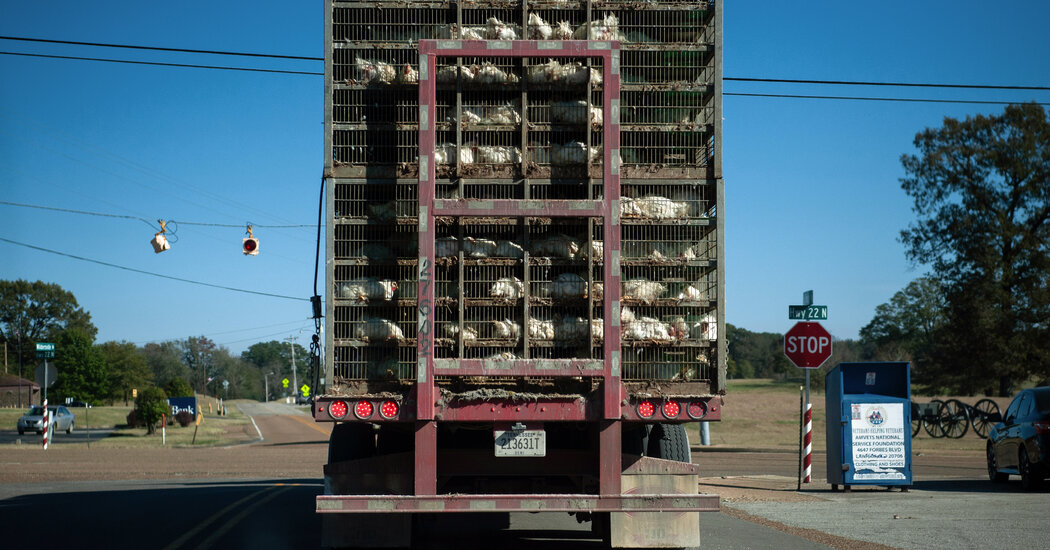Few prices are as visible to Americans as the ones they encounter at the grocery store or drive-through window, which is why two years of rapid food inflation have been a major drag for U.S. households and the Biden administration.
Shoppers have only slowly regained confidence in the state of the economy as they pay more to fill up their carts, and President Biden has made a habit of shaming food companies — even filming a Super Bowl Sunday video criticizing snack producers for their “rip off” prices.
But now, the trend in grocery and restaurant inflation appears to be on the cusp of changing.
After months of rapid increase, the cost of food at home climbed at a notably slower clip in January. And from packaged food providers to restaurant chains, companies across the food business are reporting that they are no longer raising prices as steeply. In some cases that’s because consumers are finally pushing back against price increases after years of spending through them. In others, it’s because the prices that companies pay for inputs like packaging and labor are no longer rising as sharply.
Even if food inflation cools, it does not mean that your grocery bill or restaurant check will get smaller: It just means it will stop climbing so quickly. Most companies are planning smaller price increases rather than outright price cuts. Still, when it comes to the question of whether rapid jumps in grocery and restaurant prices are behind us, what executives are telling investors offer some reason for hope.
Some, but not all, consumers are saying no.
Executives have found in recent months that they can raise prices only so high before consumers cut back.
The soda and snack maker PepsiCo had raised prices by double-digit percentages for seven straight quarters, and while that streak ended at the close of 2023, PepsiCo still raised prices by 9 percent in the final months of the year.
But all those price jumps on sodas and chips have started to bite. The company recently posted a surprise drop in sales.
Ramon Laguarta, PepsiCo’s chief executive, said on a recent earnings call that the company would be less likely to raise prices beyond “normal pricing levels” — around 2 to 3 percent per year. The firm is seeing milder cost increases on ingredients and is focusing more on keeping sales up, he explained.
James Quincey, the chief executive of Coca-Cola, explained on a recent earnings call that the company had seen a stark divide among U.S. customers: Some are under financial stress and are facing a “real spending power squeeze,” while others “still have plenty of money, plenty of purchasing power” to spend on lactose-free milk and protein shakes.
Walmart, the nation’s largest retailer, reported strong U.S. sales in the fourth quarter, in part as more higher-income households turned to the value chain for grocery shopping.
“We continue to see a customer that’s resilient, but looking for value,” Doug McMillon, chief executive of Walmart, said during an earnings call on Tuesday. He noted that prices for food and consumable products were still “slightly” higher than a year ago.
“Prices are lower than a year ago in places like eggs, apples and deli snacks, but higher in other places, like asparagus and blackberries,” he said.
Companies are seeing a return to normal.
Some companies seem to be following the rest of the economy back to more moderate price changes. Overall inflation, as measured by the Consumer Price Index, peaked at 9.1 percent in summer 2022 but slowed to just 3.1 percent at the start of this year, while food commodity costs like beef, grains and some kinds of dairy have been easing.
“Our pricing broadly is coming down in line with kind of inflation getting back to, what I’ll call more normal levels,” Ian Borden, chief financial officer at McDonald’s, said on a call with investors. (McDonald’s executives also noted that they were seeing some lower-income customers spend less per visit.)
Shake Shack, the burger and ice cream chain, is planning on raising prices by 2.5 percent this year — a return to the sort of increases that were normal before the pandemic, Katie Fogertey, the company’s chief financial officer, said on a recent earnings call.
But she noted that some stores would need to raise prices by more than that to offset increasing costs. In particular, that is true in markets where workers are hard to find and bigger price increases are needed to “offset wage inflationary pressures,” she said.
Such comments underline an important point. Many companies have taken advantage of inflation to pad profits, but for the past several years, some portion of grocery and restaurant price increases has been aimed at covering higher costs. Wages have been rising rapidly in the hospitality and retail sectors, and key ingredients had been expensive amid supply chain problems, Russia’s invasion of Ukraine and bouts of avian flu.
Companies typically at least try to raise prices when the cost of doing business climbs to avoid losing profits. But as wage and input cost pressures begin to fade, companies can stop aggressively lifting prices without risking a hit to their bottom line.
Some firms are turning to technology.
Of course, there is a way to cover higher costs without raising prices: Companies can improve their productivity, so that each worker can stock more shelves, flip more burgers or wait more tables. That is, partly, what Wendy’s is doing.
The fast food chain is rolling out digital menus, hoping they enable “immediate benefits to order accuracy, improve crew experience” and allow for sales growth, Kirk Tanner, the company’s chief executive, said on a recent earnings call.
Wendy’s also plans to try out “dynamic pricing,” he said, using technology to change prices to meet consumer demand. Another company executive suggested that the company expected “low single digit prices” this year.
This all adds up to cooler food inflation.
Taken together, the signs suggest that grocery and restaurant inflation is likely to prove more moderate in 2024 than it was in the previous three years.
Many food-related input costs are either coming down or jumping less aggressively. Wage gains remain elevated in food service, but they are cooling back toward normal. And consumers are beginning to push back on the kind of big price increases that firms were using to pad their profit margins.
Michael Swanson, chief agricultural economist at Wells Fargo, expects grocery inflation to cool to 0.5 percent this year — “much slower than it’s been” — although restaurant inflation could remain stronger as people continue to open their wallets to eat out.
Even there, he said, “it’s going to trend down.”
Jordyn Holman contributed reporting.


